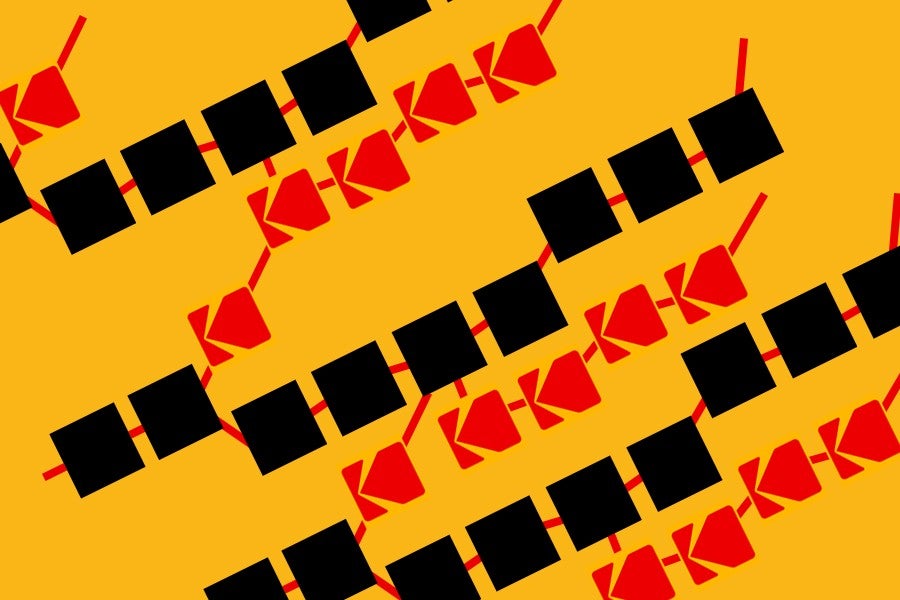Lately, companies have found that one of the quickest, most foolproof ways to improve on their public perception is to talk about using blockchain, the esoteric software infrastructure that powers the burgeoning cryptocurrency market. A few pertinent examples:
- In October, British tech incubator On-line Plc saw its stock price jump by 394 percent after changing its name to On-line Blockchain Plc.
- Riot Blockchain saw a 600 percent surge in its stock price after changing its name from Bioptix and shifting its focus away from biotech and toward investing in blockchain technologies.
- Last week, the stock price for restaurant holding company Chanticleer Holdings — which own a collection of restaurant properties, including nine Hooters locations — increased 50 percent after announcing the company is migrating its loyalty program to blockchain.
- And just this week, Kodak’s stock price saw a similar uptick after saying it will use blockchain technology to manage the rights to digital photographs.
That the mere mention of blockchain is enough to move markets speaks to the sheer power of the technology, which some digital industry executives say could be as transformative for our economy as the internet itself. But the drastic swings in market valuation also indicate the somewhat irrational levels of hype surrounding blockchain — hype that, like Bitcoin, may never be realized.
“It’s a little scary,” says Eric Franchi, a partner at MathCapital, a VC firm that specializes in marketing and media technology. “This is eerily reminiscent of the Dot-Com Bubble in 1999 and 2000, when if a company’s name ended with ‘Dot Com,’ they automatically had a path toward raising VC or IPO-ing. Or if it was an established company and they announced they were rolling out a website or partnering with a dot com, the stock went crazy.”
While the excitement may seem irrational, the potential business uses for blockchain are myriad, and its impact could be profound, according to Franchi.
But to understand blockchain’s business potential, you must first understand how it works (at least on an elementary level).
In layman’s terms, the blockchain is a decentralized ledger. Franchi describes it as one enormous Google Drive spreadsheet. Anyone can access and edit it, but no one can delete any of its contents. “At its heart, blockchain is a distributed approach to validate and store transactions and data without relying on a central trusted actor,” writes Thomas Prommer, the managing director of technology at prominent digital advertising agency Huge. “The benefit? Put simply, it creates a reliable, shared source of truth.”
Franchi goes as far to say that blockchain could become the basis for a new, separate internet.
But there are several more immediate business uses for the technology. The collaborative, democratized nature of blockchain is ideal for helping large corporations manage their supply chains, and the decentralized nature makes it incredibly hard to hack, which is increasingly important in light of the high-profile data breaches in recent years (see: Sony, Target, Equifax, to name just a few).
“The Kodak example of managing image property rights is actually quite valid,” Prommer says. With digital photography, there are tons of brands and media companies looking to use other people’s images — and an even large number of photographers who want to sell their images — but no central authority to ensure their photos aren’t used without payment or permission. “The blockchain technology can, theoretically, create an ecosystem that manages the copyright of an image in a distributed, transparent way.”
Still, that a company like Hooters (Hooters?!) would talk about blockchain seems like a cynical attempt to piggyback on the explosive growth in Bitcoin and other cryptocurrencies in recent months.
And while Franchi and Prommer agree that blockchain’s impact on business is inevitable, there’s yet to be any large company to demonstrate how the blockchain has improved its business. Even Hooters. “That’s not to say that it won’t be important,” says Franchi. “But right now, if there were more real outcomes, we’d hear about them.”
